Слайд 2Four Approaches
Classical (logical-inflectional)
Functional
Distributional
Complex

Слайд 3Classical (logical-inflectional
Latin Grammar
Declinable words included nouns, pronouns, verbs and participles
Indeclinable words

include adverbs, prepositions, conjunctions and interjections
Слайд 4The logical-inflectional classification is quite successful for Latin or other languages with

developed morphology and synthetic paradigms but it cannot be applied to the English language because the principle of declinability/indeclinability is not relevant for analytical languages.
Слайд 5Functional
XIX century, Henry Sweet
nominative units and particles

Слайд 6. To nominative parts of speech belonged noun-words (noun, noun-pronoun, noun-numeral, infinitive,

gerund), adjective-words (adjective, adjective-pronoun, adjective-numeral, participles), verb (finite verb, verbals – gerund, infinitive, participles)
Слайд 7while adverb, preposition, conjunction and interjection belonged to the group of particles

Слайд 8distributional approach
Charles Fries

Слайд 9complex approach
In modern linguistics, parts of speech are discriminated according to three

criteria: semantic, formal and functional.
Слайд 10The semantic criterion presupposes the grammatical meaning of the whole class of

words (general grammatical meaning).
Слайд 11The formal criterion reveals paradigmatic properties: relevant grammatical categories, the form of

the words, their specific inflectional and derivational features.
Слайд 12The functional criterion concerns the syntactic function of words in the sentence

and their combinability.
Слайд 13Thus, when characterizing any part of speech we are to describe: a)
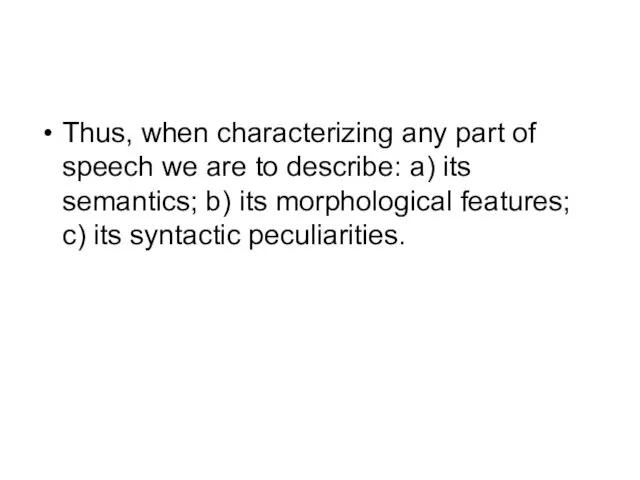
its semantics; b) its morphological features; c) its syntactic peculiarities.
Слайд 14 The linguistic evidence drawn from our grammatical study makes it possible
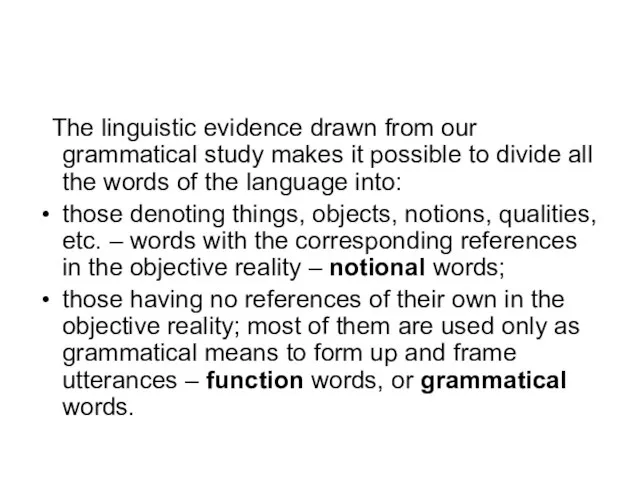
to divide all the words of the language into:
those denoting things, objects, notions, qualities, etc. – words with the corresponding references in the objective reality – notional words;
those having no references of their own in the objective reality; most of them are used only as grammatical means to form up and frame utterances – function words, or grammatical words.
Слайд 15Notional Parts of Speech
nouns, pronouns, numerals, verbs, adjectives, adverbs
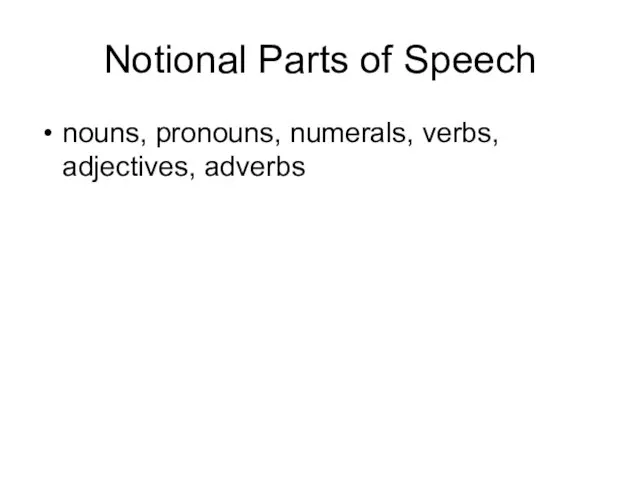
Слайд 16Functional Parts of Speech
articles, particles, prepositions, conjunctions and modal words
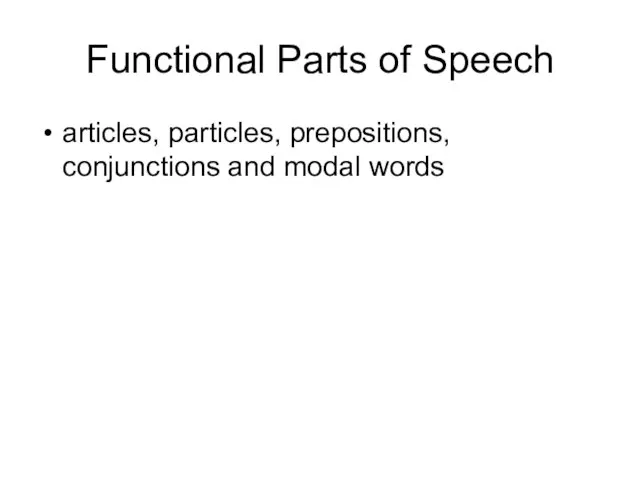
Слайд 17 The division of language units into notion and function words reveals
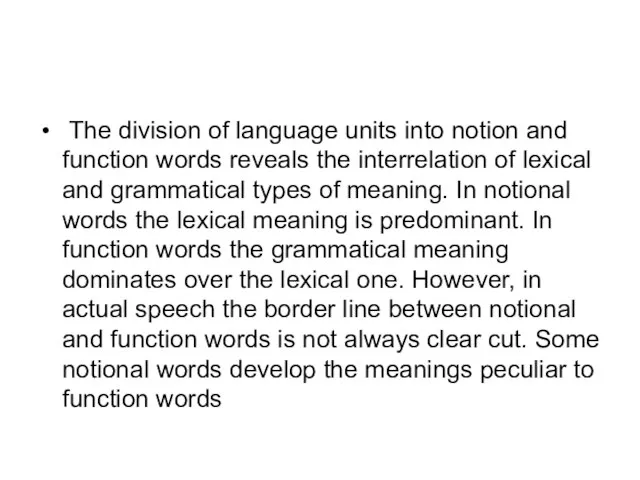
the interrelation of lexical and grammatical types of meaning. In notional words the lexical meaning is predominant. In function words the grammatical meaning dominates over the lexical one. However, in actual speech the border line between notional and function words is not always clear cut. Some notional words develop the meanings peculiar to function words
Слайд 18Notional words constitute the bulk of the existing word stock while function
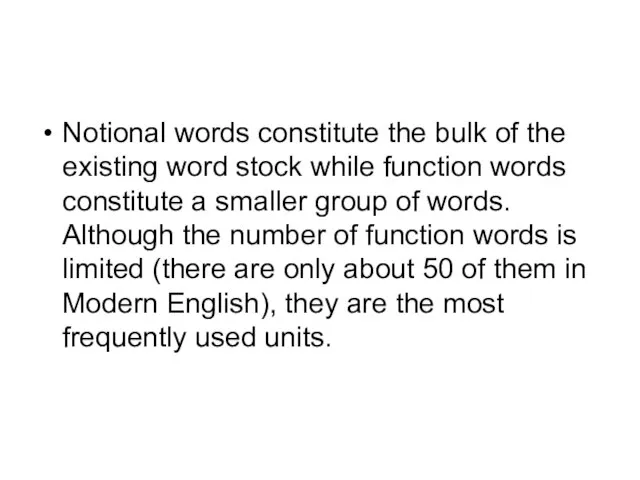
words constitute a smaller group of words. Although the number of function words is limited (there are only about 50 of them in Modern English), they are the most frequently used units.
Слайд 19Generally speaking, the problem of words’ classification into parts of speech is
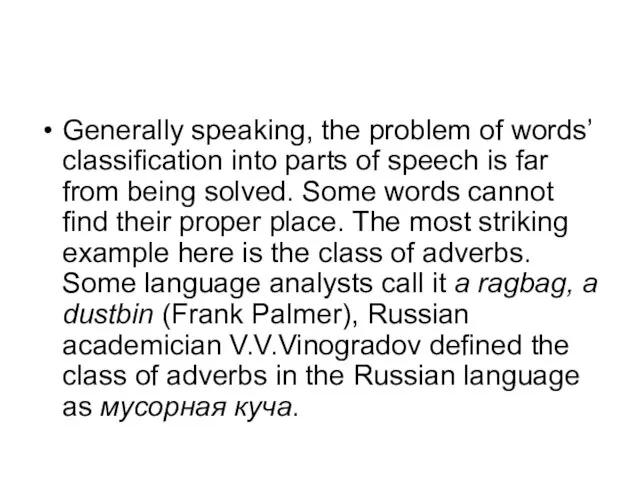
far from being solved. Some words cannot find their proper place. The most striking example here is the class of adverbs. Some language analysts call it a ragbag, a dustbin (Frank Palmer), Russian academician V.V.Vinogradov defined the class of adverbs in the Russian language as мусорная куча.
Слайд 20Compare: perfectly (She speaks English perfectly) and again (He is here again)
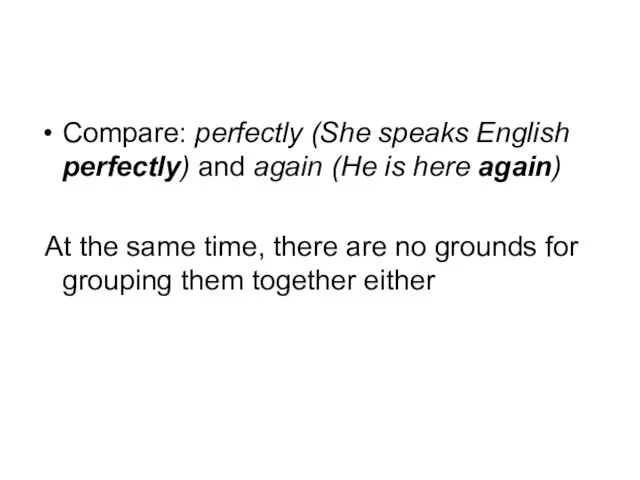
At the same time, there are no grounds for grouping them together either
Слайд 21There are some words that do not belong anywhere - e.g. after
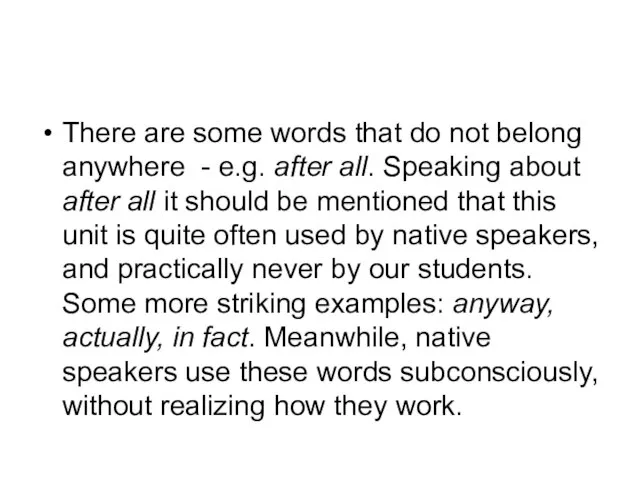
all. Speaking about after all it should be mentioned that this unit is quite often used by native speakers, and practically never by our students. Some more striking examples: anyway, actually, in fact. Meanwhile, native speakers use these words subconsciously, without realizing how they work.




















 Процессный подход
Процессный подход  эмо
эмо Моделирование поясной одежды. Модели юбок
Моделирование поясной одежды. Модели юбок Halloween. Traditions and Safety Tips
Halloween. Traditions and Safety Tips Пишем этюды. Земля хороша собой
Пишем этюды. Земля хороша собой Обои и шторы у тебя дома
Обои и шторы у тебя дома Мальчики и девочки – два разных мира
Мальчики и девочки – два разных мира Готическая архитектура
Готическая архитектура Составление и решение задач разного типа различными способами
Составление и решение задач разного типа различными способами Растительный организм
Растительный организм Политические партии. Типы политических партий
Политические партии. Типы политических партий Сравнительная характеристика ультрафильтрационных модулей на полых волокнах и рулонных обратноосмотических элементов.
Сравнительная характеристика ультрафильтрационных модулей на полых волокнах и рулонных обратноосмотических элементов. Секреты дружбы
Секреты дружбы Презентация на тему Весёлая геометрия Для самых маленьких
Презентация на тему Весёлая геометрия Для самых маленьких  Proverbs and sayings
Proverbs and sayings Our Common Future. The Bruntland Commission, UNESCO (1987) meeting the needs of the present without compromising the ability of future generation to meet.
Our Common Future. The Bruntland Commission, UNESCO (1987) meeting the needs of the present without compromising the ability of future generation to meet. С мамой в спорте
С мамой в спорте Профессия «программист» Николай Гребенщиков Ведущий специалист – ЗАО «Ланит-Терком», Санкт-Петербург Доцент, к.т.н., ХГУ им. Н.Ф. К
Профессия «программист» Николай Гребенщиков Ведущий специалист – ЗАО «Ланит-Терком», Санкт-Петербург Доцент, к.т.н., ХГУ им. Н.Ф. К Мальцева Нина Васильевнаучитель начальных классов МОУ СОШ №11с.КонстантиновскогоПетровского районаСтавропольского края
Мальцева Нина Васильевнаучитель начальных классов МОУ СОШ №11с.КонстантиновскогоПетровского районаСтавропольского края Многоугольники 8 класс
Многоугольники 8 класс Manager_4
Manager_4 Click to edit Master title style Click to edit Master subtitle style
Click to edit Master title style Click to edit Master subtitle style  Презентация на тему Опыление у цветковых растений
Презентация на тему Опыление у цветковых растений  Федеральный государственный стандарт начального общего образования: актуальные вопросы введения
Федеральный государственный стандарт начального общего образования: актуальные вопросы введения Операционная система
Операционная система Дарите людям добро
Дарите людям добро Классный час по теме: "Конфликт и пути его решения"
Классный час по теме: "Конфликт и пути его решения" Интеллектуальная транспортная система города Минска
Интеллектуальная транспортная система города Минска